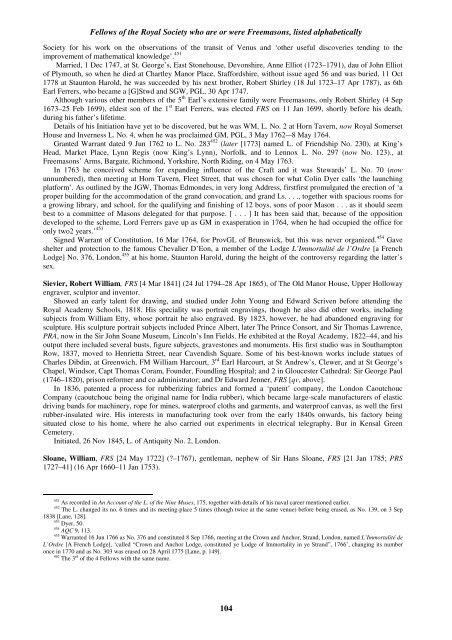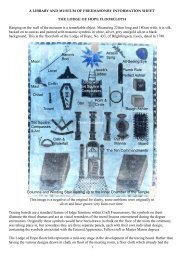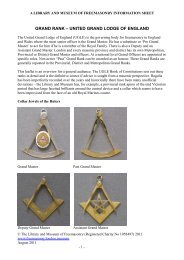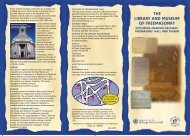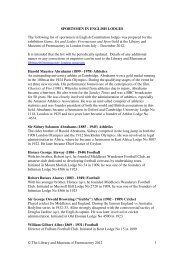FREEMASONS AND THE ROYAL SOCIETY Alphabetical List of ...
FREEMASONS AND THE ROYAL SOCIETY Alphabetical List of ...
FREEMASONS AND THE ROYAL SOCIETY Alphabetical List of ...
Create successful ePaper yourself
Turn your PDF publications into a flip-book with our unique Google optimized e-Paper software.
Fellows <strong>of</strong> the Royal Society who are or were Freemasons, listed alphabetically<br />
Society for his work on the observations <strong>of</strong> the transit <strong>of</strong> Venus and ‘other useful discoveries tending to the<br />
improvement <strong>of</strong> mathematical knowledge’. 451<br />
Married, 1 Dec 1747, at St. George’s, East Stonehouse, Devonshire, Anne Elliot (1723–1791), dau <strong>of</strong> John Elliot<br />
<strong>of</strong> Plymouth, so when he died at Chartley Manor Place, Staffordshire, without issue aged 56 and was buried, 11 Oct<br />
1778 at Staunton Harold, he was succeeded by his next brother, Robert Shirley (18 Jul 1723–17 Apr 1787), as 6th<br />
Earl Ferrers, who became a [G]Stwd and SGW, PGL, 30 Apr 1747.<br />
Although various other members <strong>of</strong> the 5 th Earl’s extensive family were Freemasons, only Robert Shirley (4 Sep<br />
1673–25 Feb 1699), eldest son <strong>of</strong> the 1 st Earl Ferrers, was elected FRS on 11 Jan 1699, shortly before his death,<br />
during his father’s lifetime.<br />
Details <strong>of</strong> his Initiation have yet to be discovered, but he was WM, L. No. 2 at Horn Tavern, now Royal Somerset<br />
House and Inverness L. No. 4, when he was proclaimed GM, PGL, 3 May 1762-–8 May 1764.<br />
Granted Warrant dated 9 Jun 1762 to L. No. 283 452 (later [1773] named L. <strong>of</strong> Friendship No. 230), at King’s<br />
Head, Market Place, Lynn Regis (now King’s Lynn), Norfolk, and to Lennox L. No. 297 (now No. 123)., at<br />
Freemasons’ Arms, Bargate, Richmond, Yorkshire, North Riding, on 4 May 1763.<br />
In 1763 he conceived scheme for expanding influence <strong>of</strong> the Craft and it was Stewards’ L. No. 70 (now<br />
unnumbered), then meeting at Horn Tavern, Fleet Street, that was chosen for what Colin Dyer calls ‘the launching<br />
platform’. As outlined by the JGW, Thomas Edmondes, in very long Address, firstfirst promulgated the erection <strong>of</strong> ‘a<br />
proper building for the accommodation <strong>of</strong> the grand convocation, and grand Ls. . . ., together with spacious rooms for<br />
a growing library, and school, for the qualifying and finishing <strong>of</strong> 12 boys, sons <strong>of</strong> poor Mason . . . as it should seem<br />
best to a committee <strong>of</strong> Masons delegated for that purpose. [ . . . ] It has been said that, because <strong>of</strong> the opposition<br />
developed to the scheme, Lord Ferrers gave up as GM in exasperation in 1764, when he had occupied the <strong>of</strong>fice for<br />
only two2 years.’ 453<br />
Signed Warrant <strong>of</strong> Constitution, 16 Mar 1764, for ProvGL <strong>of</strong> Brunswick, but this was never organized. 454 Gave<br />
shelter and protection to the famous Chevalier D’Eon, a member <strong>of</strong> the Lodge L’Immortalité de l’Ordre [a French<br />
Lodge] No. 376, London, 455 at his home, Staunton Harold, during the height <strong>of</strong> the controversy regarding the latter’s<br />
sex.<br />
Sievier, Robert William, FRS [4 Mar 1841] (24 Jul 1794–28 Apr 1865), <strong>of</strong> The Old Manor House, Upper Holloway<br />
engraver, sculptor and inventor.<br />
Showed an early talent for drawing, and studied under John Young and Edward Scriven before attending the<br />
Royal Academy Schools, 1818. His speciality was portrait engravings, though he also did other works, including<br />
subjects from William Etty, whose portrait he also engraved. By 1823, however, he had abandoned engraving for<br />
sculpture. His sculpture portrait subjects included Prince Albert, later The Prince Consort, and Sir Thomas Lawrence,<br />
PRA, now in the Sir John Soane Museum, Lincoln’s Inn Fields. He exhibited at the Royal Academy, 1822–44, and his<br />
output there included several busts, figure subjects, gravestones and monuments. His first studio was in Southampton<br />
Row, 1837, moved to Henrietta Street, near Cavendish Square. Some <strong>of</strong> his best-known works include statues <strong>of</strong><br />
Charles Dibdin, at Greenwich, FM William Harcourt, 3 rd Earl Harcourt, at St Andrew’s, Clewer, and at St George’s<br />
Chapel, Windsor, Capt Thomas Coram, Founder, Foundling Hospital; and 2 in Gloucester Cathedral: Sir George Paul<br />
(1746–1820), prison reformer and co administrator; and Dr Edward Jenner, FRS [qv, above].<br />
In 1836, patented a process for rubberizing fabrics and formed a ‘patent’ company, the London Caoutchouc<br />
Company (caoutchouc being the original name for India rubber), which became large-scale manufacturers <strong>of</strong> elastic<br />
driving bands for machinery, rope for mines, waterpro<strong>of</strong> cloths and garments, and waterpro<strong>of</strong> canvas, as well the first<br />
rubber-insulated wire. His interests in manufacturing took over from the early 1840s onwards, his factory being<br />
situated close to his home, where he also carried out experiments in electrical telegraphy. Bur in Kensal Green<br />
Cemetery.<br />
Initiated, 26 Nov 1845, L. <strong>of</strong> Antiquity No. 2, London.<br />
Sloane, William, FRS [24 May 1722] (?–1767), gentleman, nephew <strong>of</strong> Sir Hans Sloane, FRS [21 Jan 1785; PRS<br />
1727–41] (16 Apr 1660–11 Jan 1753).<br />
451<br />
As recorded in An Account <strong>of</strong> the L. <strong>of</strong> the Nine Muses, 175, together with details <strong>of</strong> his naval career mentioned earlier.<br />
452<br />
The L. changed its no. 6 times and its meeting-place 5 times (though twice at the same venue) before being erased, as No. 139, on 3 Sep<br />
1838 [Lane, 128].<br />
453<br />
Dyer, 50.<br />
454<br />
AQC 9, 113.<br />
455<br />
Warranted 16 Jun 1766 as No. 376 and constituted 8 Sep 1766, meeting at the Crown and Anchor, Strand, London, named L’Immortalité de<br />
L’Ordre [A French Lodge], ‘called “Crown and Anchor Lodge, constituted ye Lodge <strong>of</strong> Immortality in ye Strand”, 1766’, changing its number<br />
once in 1770 and as No. 303 was erased on 28 April 1775 [Lane, p. 149].<br />
462 rd<br />
The 3 <strong>of</strong> the 4 Fellows with the same name.<br />
104


